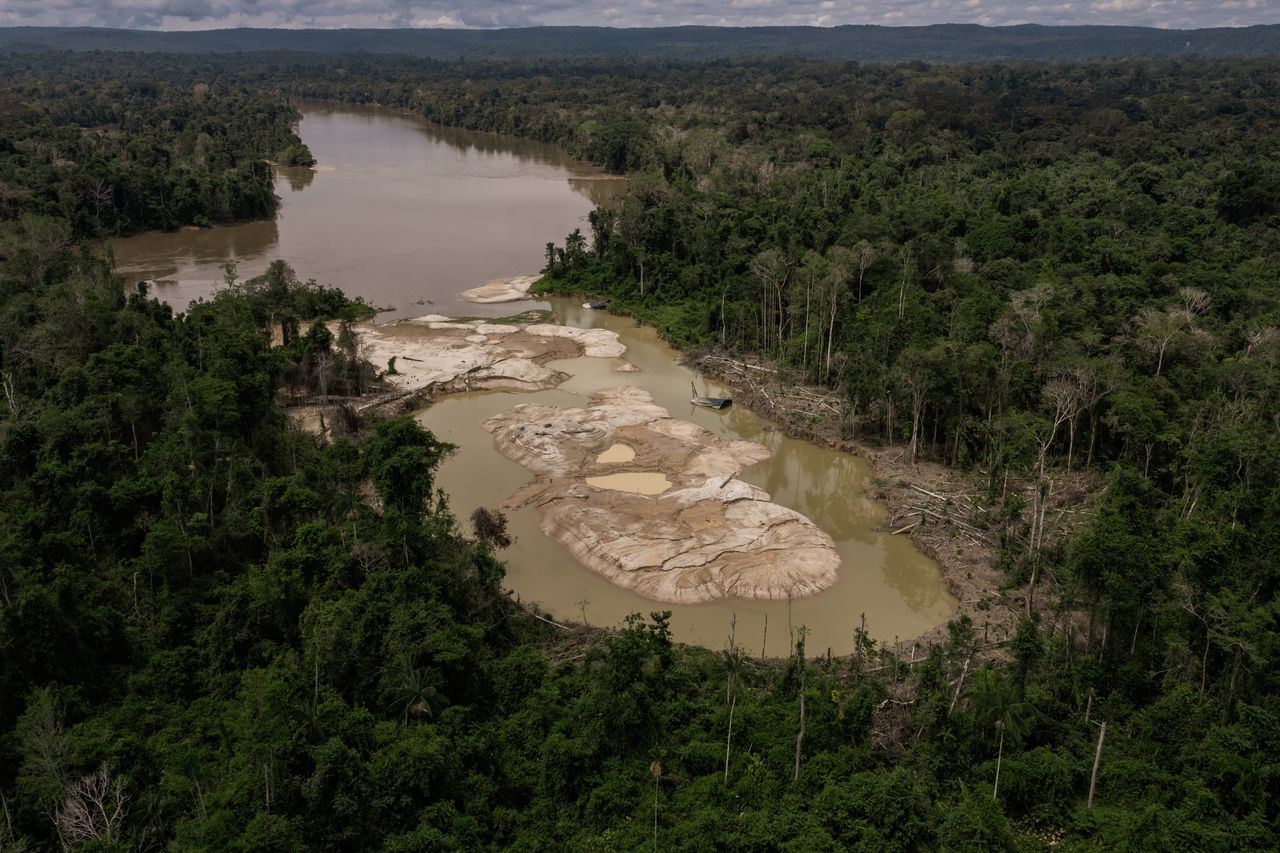Latin American Countries Aim to Curb Amazon Deforestation
Brazil’s president hosts regional leaders as rainforest risks losing ability to help offset climate change
SÃO PAULO—The Latin American countries that share the Amazon rainforest embarked on a two-day meeting Tuesday in the Brazilian jungle city of Belém with an aim to halt the deforestation that many scientists blame for accelerating climate change.
Brazil, home to 60% of the world’s biggest rainforest, held a meeting for presidents and top officials from countries that are home to the rest of the Amazon: Peru, Colombia, Bolivia, Venezuela, Ecuador, Guyana and Suriname. The summit is the first in 14 years for the Amazon Cooperation Treaty Organization, a group that arose from a treaty Amazonian nations signed in 1978 to promote harmonious development of the region. France, which oversees French Guiana on South America’s northeast shoulder, was represented by the French ambassador in Brasília.
The meeting comes as Brazilian President Luiz Inácio Lula da Silva seeks to position his country as a leading voice in the global fight against deforestation, and facilitator of cross-border environmental cooperation on the continent through the 45-year-old treaty.
“It’s never been more urgent to resume and widen this cooperation—it’s the challenge of our era,” said da Silva in his opening speech Tuesday.
Other countries with large tropical forests, such as Indonesia, Republic of Congo and the Democratic Republic of Congo, were expected to join the meeting along with Norway and Germany, which contribute to deforestation programs. The United Arab Emirates, which will host this year’s United Nations climate summit in Dubai, was also to attend.
Twice the size of India, the Amazon rainforest has long absorbed more carbon than it releases, acting as a vital brake on global climate change. But with close to 20% of the original forest now gone, scientists tracking the forest say the Amazon could be close to its so-called irreversible tipping point, at which it would dry out and eventually become savanna. The effects could be global. Climate scientists have blamed forest loss for contributing to global warming, which the U.S. Environmental Protection Agency has said explains why heat waves in countries such as the U.S. are becoming more common.
Deforestation in Brazil’s Amazon has hit its lowest level in four years since da Silva’s administration started in January, dropping about 34% in the first six months of this year compared with the same period last year, according to preliminary data from Brazil’s National Institute of Space Research, known as INPE. While da Silva has vowed to bring jungle destruction down to zero by 2030, he has argued that this can’t be done at the cost of the livelihoods of the some 30 million people who live in Brazil’s Amazon.
Instead, Brazil must build a new green economy in the Amazon with financing and investment from abroad, da Silva argues, as well as develop a regulated carbon market. Brazil relies on foreign donations to help operate its underfunded environmental enforcement agencies, which use helicopters, drones and other equipment to monitor illegal deforestation across the vast area.
“What we want is to tell the world what we’re going to do with our forests and what the world has to do to help us,” da Silva said in a government statement. Da Silva said he plans to pressure wealthy nations to fulfil the pledge they made during the 2015 Paris climate accord to provide $100 billion a year to help developing countries fight climate change.
Other Latin American countries, including Colombia and Peru, have set deforestation targets but face serious challenges from illegal mining and drug gangs that have tightened their grip over the forest in what the U.N. recently referred to as “narco-deforestation.”
Tackling deforestation is one of the most urgent tasks facing South America, scientists say.
Heavily-deforested parts of the Amazon’s southeastern region have already ceased to function as a carbon absorber and are now a carbon source, according to a study published in 2021 by Luciana Gatti, a researcher for INPE, which uses satellites to track deforestation.
The Amazon rainforest influences weather patterns around the world and as deforestation advances, this could make extreme weather events more common, said Daniel Nepstad, who heads the California-based Earth Innovation Institute and has worked in the Amazon for more than 30 years.
“The forest is a global air-conditioning unit…an enormous heat processing machine that influences weather around the world,” said Nepstad, adding that the willingness of all leaders to meet to discuss the issue was in itself a “hugely positive outcome.”
Deadly heat waves have upended daily life in large parts of the U.S., Europe and Asia this year, while unusually high temperatures in South America’s winter have melted snow in the Andes mountains.
Regional coordination is vital, environmentalists say. Deep in the Amazon, where indigenous communities often straddle borders and loggers and criminal groups move freely, one country’s efforts can easily be rendered ineffective by those of its neighbour.
Such a summit seemed a distant possibility just a year ago, when da Silva’s right-wing predecessor Jair Bolsonaro was president. Bolsonaro, who jokingly referred to himself as “Captain Chainsaw,” cut funding for environmental enforcement and bristled at attempts from foreign countries to influence his stewardship of the Amazon even as he called on them to fund deforestation efforts.
Under the conservative leader, a swath of forest bigger than Vermont was destroyed in four years, according to INPE data.
Da Silva’s election in October last year put much of South America in the hands of a group of loosely allied leftist leaders, easing regional talks on an issue, the Amazon, that had never resulted in tangible cooperation, political scientists said.
Points of conflict, to be sure, exist among the countries participating in the Belém summit.
While da Silva has mulled plans to develop offshore oil finds near the mouth of the Amazon River to help lower domestic fuel costs, his Colombian counterpart, Gustavo Petro, called last month for all new oil developments to be blocked in the region.
“As heads of state, we must assure the end of new oil and gas exploration in the Amazon,” Petro wrote last month in the Miami Herald. “We must exhibit courage, even as we address fundamental social issues within our countries, exacerbated by a cost of living crisis and rampant inflation.”
Marcio Astrini, who heads a coalition of environmental groups called the Brazilian Climate Observatory, said Amazonian countries are likely to find common ground on the need to protect indigenous communities, combat crime at the borders and support scientific research to better understand the forest.
“These countries are in different political situations…but they all found space in their agendas to agree to this and get together to discuss these sensitive issues,” said Astrini.
The biggest point they have in common, though, is their desire to get richer nations to help pay for all of this, said Astrini.
“Show me the money—that’s one thing they’ll all be saying in unison,” he said.
 Copyright 2020, Dow Jones & Company, Inc. All Rights Reserved Worldwide. LEARN MORE
Copyright 2020, Dow Jones & Company, Inc. All Rights Reserved Worldwide. LEARN MORE
This stylish family home combines a classic palette and finishes with a flexible floorplan
Just 55 minutes from Sydney, make this your creative getaway located in the majestic Hawkesbury region.
Continued stagflation and cost of living pressures are causing couples to think twice about starting a family, new data has revealed, with long term impacts expected
Australia is in the midst of a ‘baby recession’ with preliminary estimates showing the number of births in 2023 fell by more than four percent to the lowest level since 2006, according to KPMG. The consultancy firm says this reflects the impact of cost-of-living pressures on the feasibility of younger Australians starting a family.
KPMG estimates that 289,100 babies were born in 2023. This compares to 300,684 babies in 2022 and 309,996 in 2021, according to the Australian Bureau of Statistics (ABS). KPMG urban economist Terry Rawnsley said weak economic growth often leads to a reduced number of births. In 2023, ABS data shows gross domestic product (GDP) fell to 1.5 percent. Despite the population growing by 2.5 percent in 2023, GDP on a per capita basis went into negative territory, down one percent over the 12 months.
“Birth rates provide insight into long-term population growth as well as the current confidence of Australian families,” said Mr Rawnsley. “We haven’t seen such a sharp drop in births in Australia since the period of economic stagflation in the 1970s, which coincided with the initial widespread adoption of the contraceptive pill.”
Mr Rawnsley said many Australian couples delayed starting a family while the pandemic played out in 2020. The number of births fell from 305,832 in 2019 to 294,369 in 2020. Then in 2021, strong employment and vast amounts of stimulus money, along with high household savings due to lockdowns, gave couples better financial means to have a baby. This led to a rebound in births.
However, the re-opening of the global economy in 2022 led to soaring inflation. By the start of 2023, the Australian consumer price index (CPI) had risen to its highest level since 1990 at 7.8 percent per annum. By that stage, the Reserve Bank had already commenced an aggressive rate-hiking strategy to fight inflation and had raised the cash rate every month between May and December 2022.
Five more rate hikes during 2023 put further pressure on couples with mortgages and put the brakes on family formation. “This combination of the pandemic and rapid economic changes explains the spike and subsequent sharp decline in birth rates we have observed over the past four years,” Mr Rawnsley said.
The impact of high costs of living on couples’ decision to have a baby is highlighted in births data for the capital cities. KPMG estimates there were 60,860 births in Sydney in 2023, down 8.6 percent from 2019. There were 56,270 births in Melbourne, down 7.3 percent. In Perth, there were 25,020 births, down 6 percent, while in Brisbane there were 30,250 births, down 4.3 percent. Canberra was the only capital city where there was no fall in the number of births in 2023 compared to 2019.
“CPI growth in Canberra has been slightly subdued compared to that in other major cities, and the economic outlook has remained strong,” Mr Rawnsley said. “This means families have not been hurting as much as those in other capital cities, and in turn, we’ve seen a stabilisation of births in the ACT.”
This stylish family home combines a classic palette and finishes with a flexible floorplan
Just 55 minutes from Sydney, make this your creative getaway located in the majestic Hawkesbury region.






















